External links
- Les objets de Jacques Grange, Les Échos , March 23, 2007
- ELLE
Jacques Grange | |
|---|---|
| Born | 1944 (age 79–80) |
| Nationality | French |
| Occupation | Interior designer |
Jacques Grange, born in 1944, is a French interior designer.
After completing his training at the École Boulle and the École Camondo, Grange made a career as a decorator in France and abroad from the 1970s. His main customers included Yves Saint Laurent and Pierre Bergé, for whom he decorated the Château Gabriel, in Benerville-sur-Mer. The residence was previously owned by the publisher of Marcel Proust. As Saint Laurent was an admirer of Proust, Grange modelled the house around the themes of his great novel, In Search of Lost Time . [1]
His usual customers include Isabelle Adjani, Princess Caroline of Monaco, Alain Ducasse, François Pinault, Robert Agostinelli, Valentino and Karl Lagerfeld. [2] [3] In New York City, he provided the decoration of jewelry shop of Paloma Picasso, of the Mark Hotel on Madison Avenue, and of the Barbizon Hotel.
His style is characterized by a harmony between traditional and contemporary tastes, with an assortment of styles that follows the line of Madeleine Castaing, [4] who taught him the art of decoration. [5]
In 1980, Grange acquired Colette's apartment, at the Palais-Royal in Paris. He rearranged it in order to make it his residence while respecting the spirit of the place. [6]
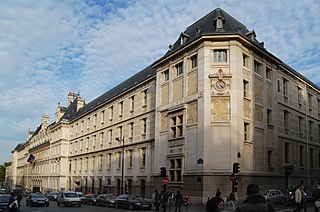
The Lycée Louis-le-Grand, also referred to simply as Louis-le-Grand or by its acronym LLG, is a public Lycée located on rue Saint-Jacques in central Paris. It was founded in the early 1560s by the Jesuits as the Collège de Clermont, was renamed in 1682 after King Louis XIV, and has remained at the apex of France's secondary education system despite its disruption in 1762 following the suppression of the Society of Jesus. It offers both a high school curriculum, and a Classes Préparatoires post-secondary-level curriculum in the sciences, business and humanities.
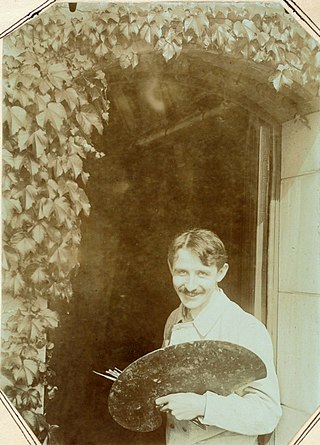
Jacques Majorelle, son of the celebrated Art Nouveau furniture designer Louis Majorelle, was a French painter. He studied at the École des Beaux-Arts in Nancy in 1901 and later at the Académie Julian in Paris with Schommer and Royer. Majorelle became a noted Orientalist painter, but is most remembered for constructing the villa and gardens that now carry his name, the Majorelle Garden in Marrakech.

The Musée Carnavalet in Paris is dedicated to the history of the city. The museum occupies two neighboring mansions: the Hôtel Carnavalet and the former Hôtel Le Peletier de Saint Fargeau. On the advice of Baron Haussmann, the civil servant who transformed Paris in the latter half of the 19th century, the Hôtel Carnavalet was purchased by the Municipal Council of Paris in 1866; it was opened to the public in 1880. By the latter part of the 20th century, the museum was full to capacity. The Hôtel Le Peletier de Saint Fargeau was annexed to the Carnavalet and opened to the public in 1989.
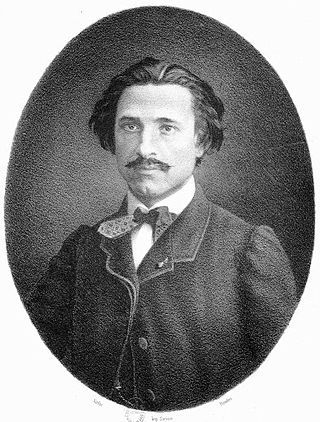
Paul-Jacques-Aimé Baudry was a French painter.

Pierre Contant d'Ivry, was a French architect and designer working in a chaste and sober Rococo style and in the goût grec phase of early Neoclassicism.
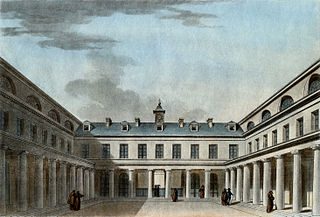
The Lycée Condorcet is a school founded in 1803 in Paris, France, located at 8, rue du Havre, in the city's 9th arrondissement. It is one of the four oldest high schools in Paris and also one of the most prestigious. Since its inception, various political eras have seen it given a number of different names, but its identity today honors the memory of the Marquis de Condorcet. The school provides secondary education as part of the French education system. Henri Bergson, Horace Finaly, Claude Lévi-Strauss, Marcel Proust, Jean-Luc Marion, Francis Poulenc and Paul Verlaine are some of the students who attended the Lycée Condorcet.

French Baroque architecture, usually called French classicism, was a style of architecture during the reigns of Louis XIII (1610–1643), Louis XIV (1643–1715) and Louis XV (1715–1774). It was preceded by French Renaissance architecture and Mannerism and was followed in the second half of the 18th century by French Neoclassical architecture. The style was originally inspired by the Italian Baroque architecture style, but, particularly under Louis XIV, it gave greater emphasis to regularity, the colossal order of facades, and the use of colonnades and cupolas, to symbolize the power and grandeur of the King. Notable examples of the style include the Grand Trianon of the Palace of Versailles, and the dome of Les Invalides in Paris. In the final years of Louis XIV and the reign of Louis XV, the colossal orders gradually disappeared, the style became lighter and saw the introduction of wrought iron decoration in rocaille designs. The period also saw the introduction of monumental urban squares in Paris and other cities, notably Place Vendôme and the Place de la Concorde. The style profoundly influenced 18th-century secular architecture throughout Europe; the Palace of Versailles and the French formal garden were copied by other courts all over Europe.
The Comité Colbert is an association "to promote the concept of luxury." The members are 81 French luxury brands. It was founded in 1954 by Jean-Jacques Guerlain.
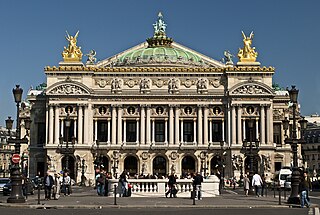
Second Empire style, also known as the Napoleon III style, is a highly eclectic style of architecture and decorative arts, which uses elements of many different historical styles, and also made innovative use of modern materials, such as iron frameworks and glass skylights. It flourished in the Second French Empire during the reign of Emperor Napoleon III (1852–1870) and had an important influence on architecture and decoration in the rest of Europe and North America. Major examples of the style include the Opéra Garnier (1862–1871) in Paris by Charles Garnier, the Bibliothèque nationale de France, the Church of Saint Augustine (1860–1871), and the Philadelphia City Hall (1871–1901). The architectural style was closely connected with Haussmann's renovation of Paris carried out during the Second Empire; the new buildings, such as the Opéra, were intended as the focal points of the new boulevards.
Emilio Rene Terry y Sánchez (1890–1969), known as Emilio Terry was a French architect, artist, interior decorator and landscape designer of Cuban-Irish ancestry. Creating furniture, tapestries and objets d'art, he was influenced by the château de Chenonceau, acquired by his family, and he created a style that was at once classical and baroque, which he called the "Louis XVII style".
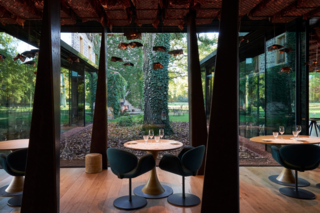
Troisgros is a French restaurant and hotel with a primary location in Ouches and additional affiliated restaurants in Roanne and Iguerande, in France.

Madeleine Castaing was a French antiques dealer and interior designer of international renown. She was the friend and the sponsor of many artists, including Soutine, who made her portrait in 1928. Original, even whimsical, she revolutionized the world of decoration, creating the style Castaing which is now a reference.
Rachid Khimoune is a French sculptor of Algerian descent born on April 7, 1953, in Decazeville, Aveyron.
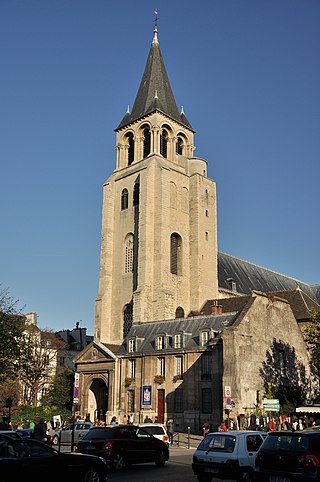
The city of Paris has notable examples of architecture of every period, from the Middle Ages to the 21st century. It was the birthplace of the Gothic style, and has important monuments of the French Renaissance, Classical revival, the Flamboyant style of the reign of Napoleon III, the Belle Époque, and the Art Nouveau style. The great Exposition Universelle (1889) and 1900 added Paris landmarks, including the Eiffel Tower and Grand Palais. In the 20th century, the Art Deco style of architecture first appeared in Paris, and Paris architects also influenced the postmodern architecture of the second half of the century.
Camille-Auguste Gastine was a French painter.

Louis Bernard Bonnier was a French architect known for his work as an urban planner for the city of Paris. He was instrumental in loosening the restrictions on the appearance of buildings in Paris, which resulted in the blossoming of Art Nouveau buildings. He designed many significant buildings himself, including private villas, public housing and railway buildings. In all his work he was true to the rationalist principles of Art Nouveau.

Neoclassicism is a movement in architecture, design and the arts which emerged in France in the 1740s and became dominant in France between about 1760 to 1830. It emerged as a reaction to the frivolity and excessive ornament of the baroque and rococo styles. In architecture it featured sobriety, straight lines, and forms, such as the pediment and colonnade, based on Ancient Greek and Roman models. In painting it featured heroism and sacrifice in the time of the ancient Romans and Greeks. It began late in the reign of Louis XV, became dominant under Louis XVI, and continued through the French Revolution, the French Directory, and the reign of Napoleon Bonaparte, and the Bourbon Restoration until 1830, when it was gradually replaced as the dominant style by romanticism and eclecticism.
Jacques Guérin was a French industrialist. For many years he successfully headed up the D'OrsayParfumerie business after inheriting it in 1936 from his remarkable mother, Jeanne Louise Guérin. Beyond the world of commerce Jacques Guérin is better known by many as a passionate collector of books and manuscripts. One reviewer, paraphrasing the sentiments of several commentators, has described him as "not just a collector but a rescuer of all things Proustian".
Jacques Yankel, born Jakob Kikoïne was a French painter, sculptor, and lithographer.